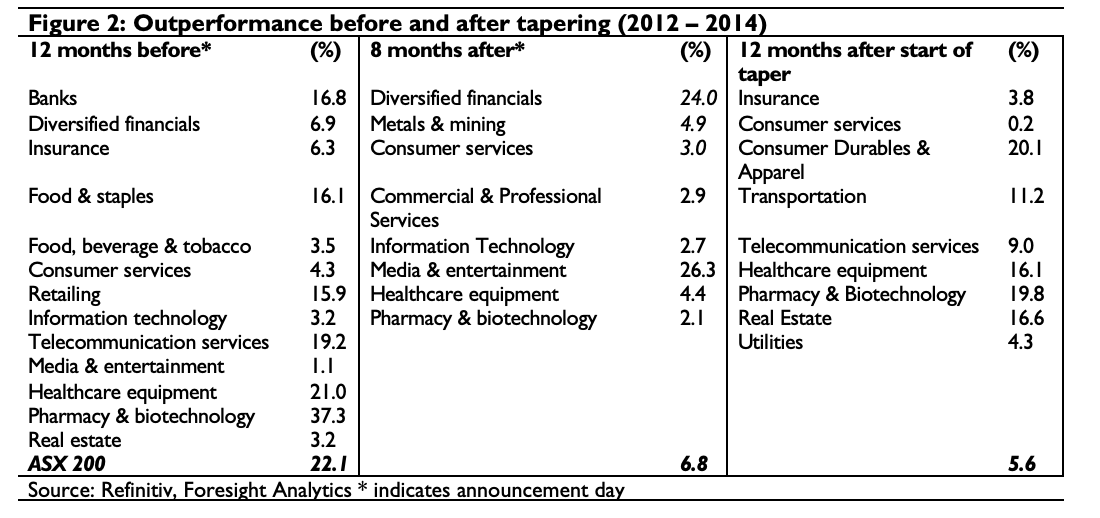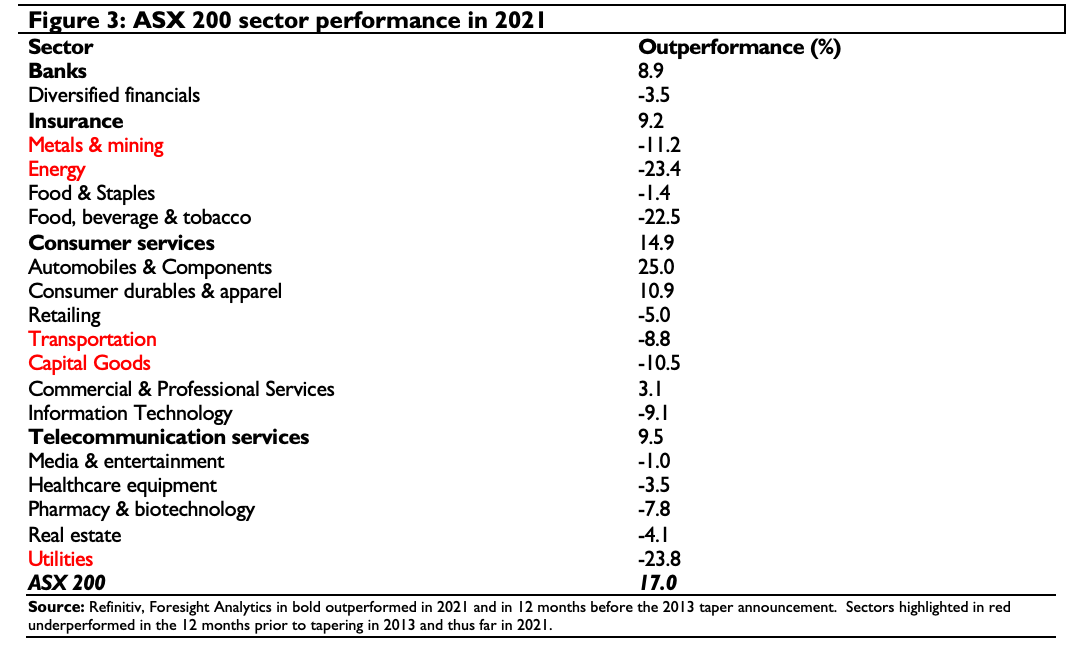Should you own value or growth as the Fed begins to tighten?

Foresight Analytics
In our last note on Fed tapering, we highlighted both similarities and differences in markets now compared to the 2013 tapering event.
In May 2013, Ben Bernanke was Fed Chair when he famously told markets of the Fed’s intention to taper its asset purchase program. It took 8 months for the Fed to begin tapering after the announcement, but over that period bond yields rose from 1.7% to 3.0%. After tapering began, they fell back to a little below 1.7% some 12 months after tapering began.
Last week Fed Chair Jerome Powell took another step towards preparing markets for Fed tapering. Indeed, he specifically mentioned “Participants generally view, so long as the recovery remains on track, a gradual tapering process that concludes around the middle of next year is likely to be appropriate”. Markets have generally taken these comments in their stride thus far and this is probably due to the carefully designed messaging by the Fed Chair.
For example, last week he was quick to break the link between the tapering of asset purchases and the first increase in the Fed Funds Rate. Powell repeated his earlier stance that the start and pace of the Fed’s asset purchases “will not be intended to carry a direct signal regarding the timing of interest rate liftoff”.
The scripted language of the Fed Chairman is aimed at reducing the risk of a sharp rise in yields, but nonetheless markets are always forward looking and if the economy continues to meet Fed objectives, then bond yields will rise, it’s just a matter of how quickly.
Putting aside the different market reaction to the messaging between this year and 2013, we still think it’s worth revisiting 2013 to see how the market reacted to the Fed’s change in monetary policy stance. This may provide some guide to what may occur once the Fed approaches the removal of stimulus in the months ahead.
In our previous note, we showed how the ASX 200 outperformed the S&P 500 in the 12 months prior to the announcement. However, after the announcement to taper was made, the S&P 500 outperformed the ASX200 (Figure 1 – RHS).
Thus far this year, the Australian market has slightly underperformed the US.
In this note, we look at whether investing by style offered better returns than investing by region back in 2013 to see if there are lessons worth learning in preparation for the months ahead.
Figure 1: Equity market performance during tapering (May 2013 = 100)*


- In 2013, Value outperformed Growth, particularly in Australia, but also a little in other markets (Figure 1- LHS).
- However, once tapering was announced and yields began rising sharply, ASX 200 Growth outperformed Value. This outperformance continued throughout the period after tapering began when yields started to decline.
- In other markets, Growth and Value performed in line with each other in the 8-month period when yields were rising before tapering began, and in the following 12-month period as yields declined.
-
Our take away from this period for Australian investors is that in the local market, the batten change over from Value to Growth could occur again. However, in global markets regional calls are likely to be more important that a call on style.
Australian sector performance
It’s worth looking at sector performance in the Australian market during tapering, given Value’s outperformance in the lead up to the tapering announcemen and Growth’s outperformance in the 8 months after the announcement when yields rose, and the following 12-month period when they fell back to their pre-announcement level.
-
In the 12-month period prior to the announcement: The ASX 200 returned 22.1%, led by strong gains in Pharmacy and biotechnology (37.3%), Healthcare equipment (21.0%), Telecommunications (19.2%) and Banks (16.8%). In this period, the US 10-year yield rose from 1.5% to 1.7% and the Australian 10-year yield fell from 4.1% to 3.1%.
-
In the 8-month period following the announcement but before the start of tapering: The ASX 200 returned 6.8%, led by Media & entertainment (26.3%) and Diversified Financials (24.0%). In this period, the US 10-year yield rose from 1.67% to 3.0% and the Australian 10-year yield rose from 3.1% to 4.2%.
-
In the 12-month period after tapering began: The ASX 200 returned only 5.6%, with Consumer durables (20.1%), Pharmacy and biotechnology (19.8%), Real estate (16.6%), and Healthcare equipment (16.1%) leading the outperformance.
-
Healthcare equipment, Pharmacy & biotechnology and Consumer services were the only sectors outperforming in the lead up to the tapering announcement, immediately after the announcement and in the 12-month period after tapering began.
-
Metals and mining underperformed in the lead up to tapering and in the 12-month period after tapering began. However, the sector outperformed in the 8-month period when global yields were increasing just after the announcement.
-
Insurance, Telecommunication services, and Real estate outperformed in the lead up to the announcement and in the 12-month period after tapering began.
-
Energy, Automobiles & components, Capital goods underperformed before during and after tapering was announced.
- Banks, Food and staples, Food, beverage & tobacco, retailing all underperformed after tapering was announced. 0

-
Banks, Insurance, Consumer Services and Telecommunications are outperforming thus far in 2021 and also outperformed in the lead up to tapering in 2013.
- Metals and Mining, Energy, Transportation, Capital Goods, and Utilities have all underperformed thus far in 2021 and also underperformed in the lead up to tapering in 2013. 0

Valuation premium
- Both Growth and Value were becoming more expensive prior to the announcement of tapering in 2013 (Figure 4). Prior to tapering this was driven by strong equity market returns. Bond yields were declining a little during this period and providing support for equity market valuation.
- However, after the tapering was announced and bond yields rose, the equity market risk premium declined further. The rally in bond yields after tapering began bought about a stability to valuations at stretched levels and helped equities rally further.
- Importantly, the valuation premium of growth over value remained relatively consistent during the trading period before tapering was announced and the period after.
- Fast forward to 2021 and Growth is significantly more expensive than Value after adjusting for the level of bond yields. Value, however, is as expensive as it was back in 2013.
Figure 4: Equity risk premium by style in 2013

Conclusion
-
Australian investors should be prepared for the outperformance baton to shift from Value to Growth if 2013 is a guide. However, in global markets regional calls are likely to be more important that a call on style. However, Growth is significantly more overvalued relative to both bonds and Value than it was in 2013 and this could be its Achilles heel.
-
Consumer services is outperforming now it they did back in 2013. It was also the only sector than managed to outperform during all phases of tapering in 2013.
-
Insurance, Telecommunication services, and Real estate performed well during periods when the bond market was rallying – before and during tapering.
- Banks, Food and staples, Food, Beverage & tobacco, and Retailing all underperformed after tapering intentions were announced.
Never miss an insight
Enjoy this wire? Hit the ‘like’ button to let us know. Stay up to date with my content by hitting the ‘follow’ button below and you’ll be notified every time I post a wire.
Not already a Livewire member? Sign up today to get free access to investment ideas and strategies from Australia’s leading investors.

Shane Lee is a strategist at Foresight Analytics. He has as around 20 years’ experience in various sell-side research and asset allocation roles. He was the asset allocation analyst at ANZ wealth/IOOF for a 2-year period between 2017 and 2019....
Expertise

Shane Lee is a strategist at Foresight Analytics. He has as around 20 years’ experience in various sell-side research and asset allocation roles. He was the asset allocation analyst at ANZ wealth/IOOF for a 2-year period between 2017 and 2019....
